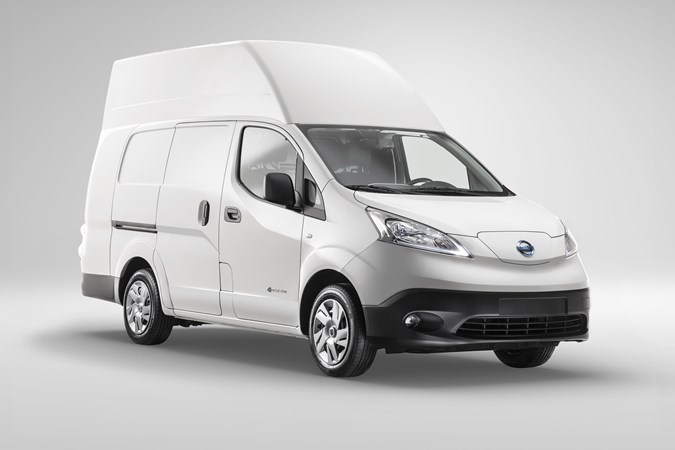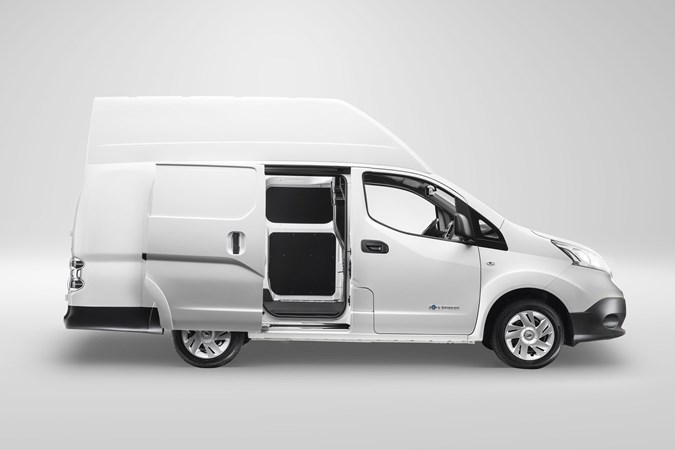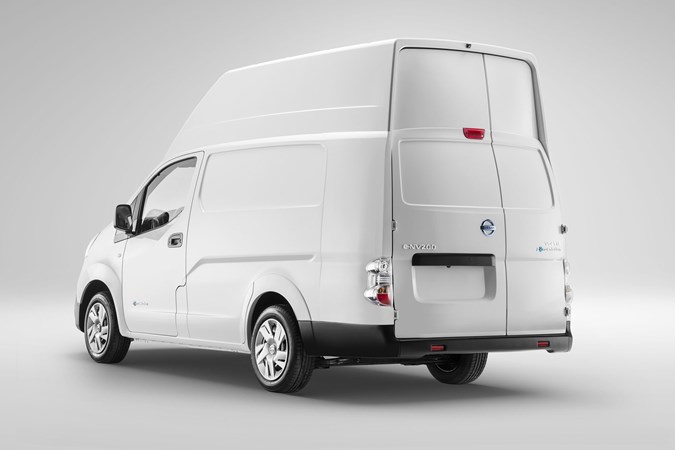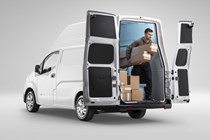It seems that 2020 is turning into the year of the medium-sized electric van, as we’re going from having none on sale in the UK to options from several manufactuers. Strictly speaking, Nissan isn’t one of them – but it has come up with a novel way to fill that niche with its existing e-NV200 electric van.
The Nissan e-NV200 is a small electric van, and a very-well proven one. Now there’s a British-built thrid-party conversion solution that dramatically increases the amount of load space it offers – to more than any medium electric van rival can offer.
In new e-NV200 XL Voltia form, this high-volume e-NV200 offers as much as 8.0 cubic metres of load capacity – enormous – and still has a claimed 124-mile driving range. Designed as a last-mile, low-emissions zone delivery van solution, it may look a little odd but we can certainly see the appeal.
And Nissan clearly agrees, as it’s making the e-NV200 XL available to buy through its own van dealers.
Who builds this high-volume e-NV200 XL conversion?
It’s being produced in the UK by the Bevan Group, an award-winning body builder better known for its truck bodies – though the design is actually under licence from Slovakian conversion specialists Voltia, which has built an entire business around upsizing the e-NV200.

At first, Bevan will be assembling the vehicle from imported panels and components, but over time – and given enough sales success – plans to recruit additional staff and begin manufacturing all of the parts at its Wednesbury base in the West Midlands.
What’s the benefit?
Massively increased space. A standard e-NV200 has a 4.2 cubic metre load volume – Bevan’s high-roof conversion offers either 6.0 cubic metres or 8.0 cubic metres, so nearly double the cargo capacity.
The height of the roof makes it possible for most people to stand up inside the back, which is handy for delivery usage, and the height of the rear doors is extended to match.

The downside is that you don’t get any increase in payload rating, so the conversion does reduce this slightly – to 580kg at best, versus 705kg for the standard van.
On the plus side, because there’s been no alteration to the overall gross vehicle weight (GVW), the conversion should offer exactly the same driving range as the standard van.
How realistic is the driving range?
The 124-mile figure is what Nissan quotes for a standard e-NV200, based on the latest WLTP standards. That’s in combined driving; if you drive mostly around town – as the majority of electric van users do – the official figure goes up to 187 miles.
Having said that, the weight of the van will likely have a dramatic impact on the driving range, meaning not only if you load it up, but also the additional heft of the conversion. So you should probably expect the real-world range of the Bevan vans to be lower than this.

The firm says it has demo vehicles available for trials if you want to get a clearer picture.
What’s the warranty?
The Nissan chassis components carry the same five-year / 60,000-mile warranty as a standard e-NV200, and Bevan matches the five-year figure for the added body components.
The e-NV200’s 40kWh battery pack is covered for eight years.
How much does the conversion cost?
Nissan is now officially supporting the conversion throughout Europe – with other countries taking them direct from Voltia.
In the UK you can order the 8.0 cubic metre version direct from a Nissan dealer, who will then arrange for a standard e-NV200 to be deliver to Bevan for conversion, and then take care of getting the finished e-NV200 XL back to you.
Alternatively, you can still liaise directly with Bevan, if you prefer.
Nissan says the conversion costs £9,950 plus VAT. That’s in addition to the basic cost of the van, of course, which currently starts at £20,005 plus VAT.
That means you’re looking at less than £30,000 for a proven electric van with a useful driving range and more load capacity than any of the medium-van rivals. That’s a bargain.
What about rivals?
To explain how much of a bargain, let’s take a look at what we know about the rivals.
First to market was the Mercedes-Benz eVito, which comes with a 92-mile driving range, maximum load volume of 6.6 cubic metres, and a basic asking price of £39,895 (which only gets you a smaller van; you’ll need over £42k for the biggest eVito). It will carry up to 923kg, though.
The closely related Citroen e-Dispatch, Peugeot e-Expert and Vauxhall Vivaro-e haven’t been priced yet, and only run to 6.1 cubic metres of load space at best. However, they do promise as much as 205 miles of driving range or 1,275kg of payload. Will be interesting to see how much they cost.
Then there’s the Volkswagen eTransporter. This has just an 82-mile driving range and a load volume of 6.7 cubic metres, and while it will carry up to 1,001kg it also costs from £42,060.
Perhaps more troubling for the e-NV200 XL is the new Maxus eDeliver 3, a medium van built to be electric from the ground up. This has up to 6.1 cubic metres of space, a promised 1,000kg payload and a predicted selling price of around £30,000 – which will fall to around £24,000 with the government plug-in van grant.
Add to that the arrival of the Ford Transit Custom Plug-In Hybrid – which should be in dealers very soon – and it will be interesting to see how this Bevan Group e-NV200 conversion fares. Initial expectations are that it will be produced at the rate of around 10 per week.
Also read:
>> The best electric vans you can buy now
>> Future electric vans coming soon
>> The Parkers guide to electric vans
>> Electric van range halves with full payload, study finds
Just so you know, we may receive a commission or other compensation from the links on this website - read why you should trust us.










